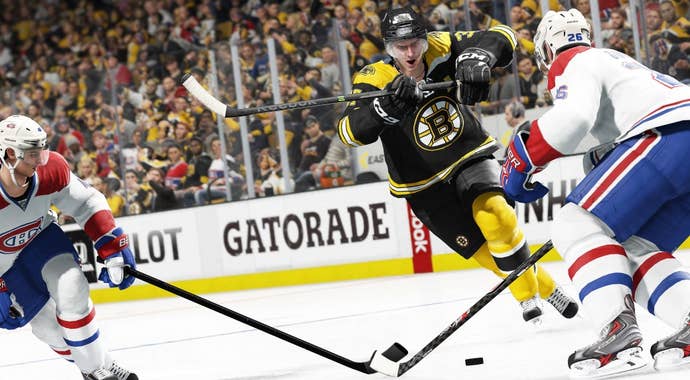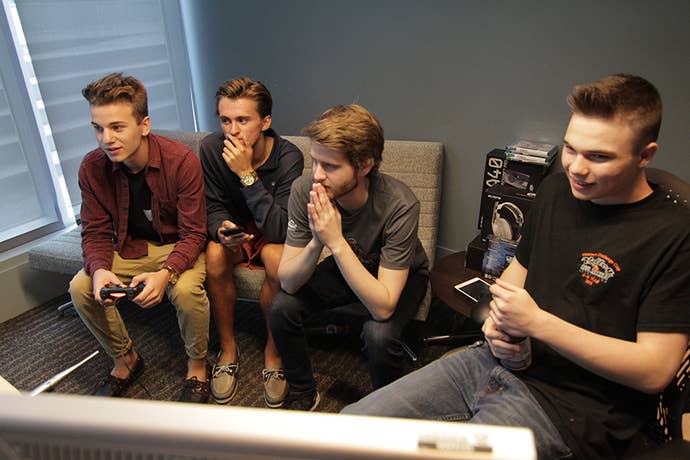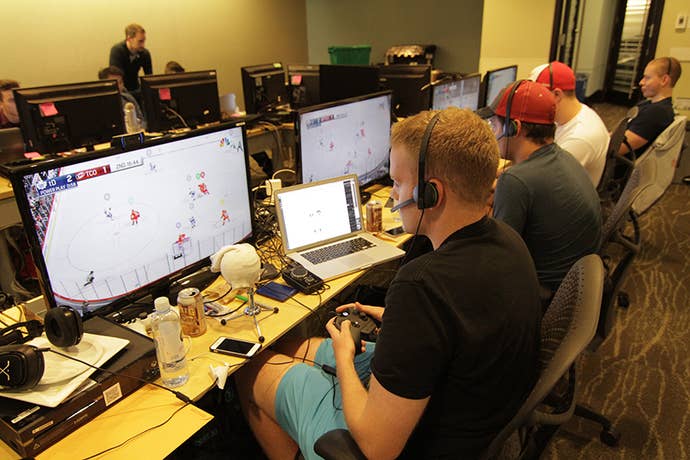Inside NHL 16: How EA Turned to the Fans to Help Rebound from a Disappointing Year
After the poor reception afforded NHL 15, the team went back to the drawing board. Then they brought in the fans.
This article first appeared on USgamer, a partner publication of VG247. Some content, such as this article, has been migrated to VG247 for posterity after USgamer's closure - but it has not been edited or further vetted by the VG247 team.
Tyler Horsfall is no stranger to EA Canada. After all, his brother once worked at the Vancouver studio, and he even knew some people on the NHL development team. Still, it was a dream come true when he was asked to contribute to NHL 16 as a "Game Changer" - a program instituted by EA designed to get feedback directly from the fans.
"The experience has been surreal," he told me when I visited Vancouver last week. "I've always wanted to work on NHL."
Horsfall is part of a select group of 12 fans voted by their respective communities to take part in the Game Changers program. They come from communities like the NHL forums and Leaguegaming, or in the case of Horsfall, from Youtube and Twitch. They are the diehards who play NHL over the course of the entire year, the ones who can drop five goals on you without breaking a sweat.
"They bring that hardest of hardcore perspective," says producer Sean Ramjasingh, popularly known as "Rammer" around the studio.
They bring something else as well. As ambassadors to their respective communities, they offer the NHL team a direct line to the fanbase, allowing them to communicate in ways that are unprecedented for an annual sports sim. In that way, they are finally catching up to fighting game developers to like Capcom, who have been tapping the expertise of the fighting game community for years.
For almost a year now, the Game Changers have been offering feedback on every aspect of NHL 16, especially the EA Sports Hockey League - arguably the franchise's flagship mode. They've flown up to Vancouver, spent hours arguing with the developers, and held dozens of late night Skype chats. Now, with NHL 16 just around the corner, they're just as invested in its success as the developers.

The Rebuilding Year
It was around this time last year that EA announced that the EASHL - an online team mode with an almost fanatical following - would not be in NHL 15. The ensuing backlash was swift and entirely predictable.
"I was pretty shocked. I was one of those guys who was going, 'It's going to come, don't worry.' When they didn't say a single word on it, I started to get a little scared," says Koden Curial, who is another Game Changer.
The absence of the EASHL was compounded by other cuts. GM Connected, custom soundtracks, and affiliate games were all gone, too. EA pointed to the newly-revamped presentation, which used NBC's broadcast package and brought in Mike "Doc" Emerick as a commentator, but the damage was done.
A lot of the cuts were a function of time. With only 12 months to work on NHL 15, it simply wasn't possible to squeeze everything in, Ramjasingh says. In fact, the EASHL cut wasn't announced until the last minute because they were "pushing like hell" to get in. "Unfortunately people think, 'Can't we just copy and paste from [the Xbox 360 and PlayStation 3] and drop it in?' Like, Ctrl-V and it's in the [Xbox One and PlayStation 4 generation]. But it's not. With the new technology, you have to rebuild all of your game modes from scratch." Still, he acknowledges that the team lost trust with their fans by cutting those features, and that trust had to be earned back.
In the wake of NHL 15, the team broke down into what Ramjasingh says was "one of the toughest pre-productions he's ever been a part of." They performed an extensive post-mortem, breaking out into groups and questioning their methodology. They kicked off the dev process earlier for NHL 16, which paid immediate dividends, and were able to knock off their initial milestones with ease.
While this was occuring, Ramjasingh and his company began reaching out to the fans directly. The first thing they did was conduct direct research, sometimes literally going to a fan's house to see the environment in which they played the game. What they found wasn't surprising, but it was nevertheless valuable. The team found that they could broadly break the fans down into four categories: Social, Competitive, Fantasy, and Ex-Joke. Social fans wanted to keep in touch with their friends, competitive fans just wanted to win, fantasy fans stuck to modes like Be a GM in bringing their favorite team to the Stanley Cup, and ex-jocks played to recapture the fun of playing their favorite sport.
"We walked into basements. We walked into some elaborate houses," says Ramjasingh. "We wanted to understand why people play our game."

The Game Changers belong to the competitive group - the hardcore fans who played at the highest difficult level and competed via sites like Leaguegaming. Ramjasingh wanted to bring them in to help tune the EASHL, but he admits that he wasn't sure what to expect. "We never knew how it was going to work. You had a wide range of ages, and we literally walked them through our early concepts that we would never show anyone outside of the studio before February, March, or April. We put a lot of trust in them, and luckily they were all great guys and they upheld the trust that we gave them and didn't put our feature set on the Internet, and really embraced the whole program we put together. To be honest, when we started this, I told everyone, 'I don't know how this could happen. It could go well. It could go badly. The NHL 16 feature set could be on the Internet the Monday following the event.'"
The Game Changers arrived for their first session in January - a collection of mostly students in their early 20s from Canada and the U.S. Upon arrival, the NHL team gave them a crash course in game development, taking them through the process step-by-step and asking them to try and develop three features. Their ideas ranged from the ability to rank EASHL teammates to an All-Star Weekend with skills games to a creation zone. The dev team then patiently explained why each idea was probably unfeasible owing to time constraints, with only the ranking idea being something approaching realistic.
"Going through that exercise, the piece of feedback we got was, 'If all the fans saw the kind of behind of scenes and the decisions you have to make, people would be more forgiving on the forums,' and that meant a lot to us," Ramjasingh said later. "For instance, 'Be a Ref mode' is something that people throw out there. That means we're not working on a gameplay feature. Do you want a Be a Ref mode? Sure. Do you want it at the expense of Gameplay Feature X? Probably not."
For the NHL team, it was an invaluable opportunity to establish a line of communication with the fans and show them exactly what it was like to make an annual sports sim. It was a move seemingly calculated to shift the narrative and generate a bit more sympathy for the developers among the fans. It worked. Even for Koden Curial, who has studied game design, the process ultimately wound up being a reality check. "I had a pretty good idea of how game design works, but I didn't realize how small the team was. For how much they get done with this small of a team is pretty crazy. They move pretty fast, and their engineers work hard to get that stuff done. I couldn't imagine how many hours they put in."
It wound up being more than a publicity move, though. Whether NHL's developers intended it or not, the Game Changers became more involved than anyone could have imagined.

In the Trenches
Over the next few months, the Game Changers visited Vancouver several times. After a quick breakfast, they would head into a conference room to play the latest build of the game. Sometimes Ben Ross, one of the main architects of NHL's gameplay, would walk in and start taking suggestions, which he would write down on the white board.
Sometimes arguments would erupt. Horsfall remembers a length battle over shot accuracy. "It got intense there sometimes. We had a good hour, hour and a half conversation over whether a player should be hitting a smaller target more often, or if their target should be smaller, or if they're more likely to hit the net with shot accuracy."
In the early going, much of the feedback was focused around the EASHL. The NHL team wanted to revamp the mode, do away with the level grind, and introduce character classes. It was up to the Game Changers to help figure out how a Playmaker would separate itself from a Sniper.
"Finding that balance is interesting," says Horsfall. "Even if you tune something up one point, it seems small, but it can make a class overpowered."
When I visited Vancouver back in May, I saw some of that feedback in action. Ross was at the white board as usual, and he was busy collecting feedback on stats. They spent some time talking about the Power Forward, a class designed to have excellent balance and a heavy slapt shot. They picked over hitting ("It felt good"), shot power, and the passing, the last of which came in for some extra attenlat/baotion. While they talked, Ross stood writing the feedback, holding an easy and conversation back and forth with the group of fans who in another world might have been savaging his game from behind their keyboards.

"We got into low, low, low level detail," Ramjasingh later remembered. "When you pass the puck at high speed, do we want a chance that you bobble the puck? You take a step back, and you realize, 'Yeah, that's exactly what we want to happen.' That's the moment we envision when it comes to gameplay balance in NHL 16."
When I asked what their main considerations were when balancing the game, Ramjasingh said, "They are all extremely competitive guys, and they don't want to feel like they're a victim of the game itself. A glitch goal, or getting unwanted behaviorial loss of control. They want as much control as possible."
The group brought that same perspective to the rest of the modes, offering feedback on the new Player Morale function in Be a GM, among other things. And as the developers came to trust them, they incorporated more and more of their feedback into the game. Just yesterday, they dropped a rather large patch derived from the feedback of the Game Changers as well as the EASHL Beta, which brought with it Ranked Quick Match in EASHL, Badges, team practices, and more.
One interesting side effect of this process is that it has made the Game Changers every bit as accountable as the developers. So when NHL's balance is criticized, they hear it too. "Really, the bulk of the EA Sports Hockey League experience was all shaped by the Game Changers. And the tuning that went into the closed beta was shaped by the Game Changers, which was pretty interesting for us because they were here representing the community, and we had them being part of the final tuning," says Ramjasingh. "So when our fans liked or didn't like the tuning, it wasn't only the producers who did that, but our representatives from the fans as well. So they were taking the heat with us when people thought things were a little unbalanced."
It would be wrong to say that NHL 16 now belongs to the Game Changers as much as the developers, but there's no denying that they've poured a tremendous amount of thought and energy into its tuning. And for that, they will either reap the benefits, or the whirlwind.

Comeback Kids
With its first year now in the books, the Game Changer program has proven to be a boon for EA. Ramjasingh is already talking about what he wants to do with it next year. "We're asking ourselves questions like, 'Do we want to scale it up? What point does qualitative feedback become quanitative feedback and just data?'"
Regardless of how they choose to go forward, it's impossible to overstate the importance of the data EA has gotten from this process. For the cost of airfare and hotel, they've had access to their fans pretty much around the clock, even holding large Skype chats with them when they go home. Horsfall even acknowledges that EA "actually got hands-on feedback from us like a really strong QA team."
In many ways, the program is a reflection of a broader trend toward implementing community feedback. Early Access exists not just because it's a convenient revenue stream, but because it's an invaluable source of feedback for the developers when handled properly. In essence, that is what the Game Changer program is, except that the fans were literally brought to the studio to interact with the development team face-to-face.
That Game Changers have benefited as well. Many of them are streamers and Youtubers, and the program has afforded them comprehensive access. On the final day, a number of Game Changers were streaming right from EA, with members of the development team like Ramjasingh and Ross periodically dropping in to play and say hello to the viewers. When it was all finished, the Game Changers got to take the finished game home two weeks early.
It's been rewarding in other ways, too. For these diehard fans, who play NHL year in and year out, the opportunity to interact directly with the developers is a dream come true. And there have been various cool experiences peppered throughout the process. At one point, Hurricanes goalie Eddie Lack came in to play a few rounds with the Game Changers, and as it turned out, he was really good at the game. Ross remembers them saying afterward, "You guys fly us in because we're supposed to be the best of the best, then you guys bring in this celebrity talent and he wipes the floor with us."
Both the developers and the Game Changers have big dreams for the future. There's much talk about the EASHL eventually becoming an actual eSport, with the classes being the first step. Horsfall's comment about about what he would like to see going forward is typically eSports-centric. "I want to see more support for offline networking and LAN and spectating capabilities. Getting into the whole eSport genre of things, it would be really cool to be able to have someone watching and commentating over it. I've been to a couple NHL tournaments in person, and everyone wants to have a [six versus six] tournament. So having the LAN possibilities for that would be cool."
That dream may well be fantasy, but the developers and Game Changers seem united in working toward that goal. For now, with NHL 16 now wrapped and set to launch next week, all that's left now is to see how the Game Changers' feedback holds up. To be sure, though, the NHL team has accomplished at least one goal: They've managed to connect with their community, and even if they haven't totally reversed the damage of NHL 15, they're at least on their way to recovery.
As for the game itself, it's looking considerably more promising than last year. Absent GM Connected, pretty much all of the modes and features are back, and there have been a number of substantial upgrades to the presentation. If the gameplay is as tuned as the development team is suggesting, it could well be the best hockey game in a while.
Regardless of how it all turns out, the Game Changers will be back next year, possibly with some additions. Horsfall, for his part, is ready. Asked whether he would want to do it all again, his answer was simple: "Yes. Hands down."









